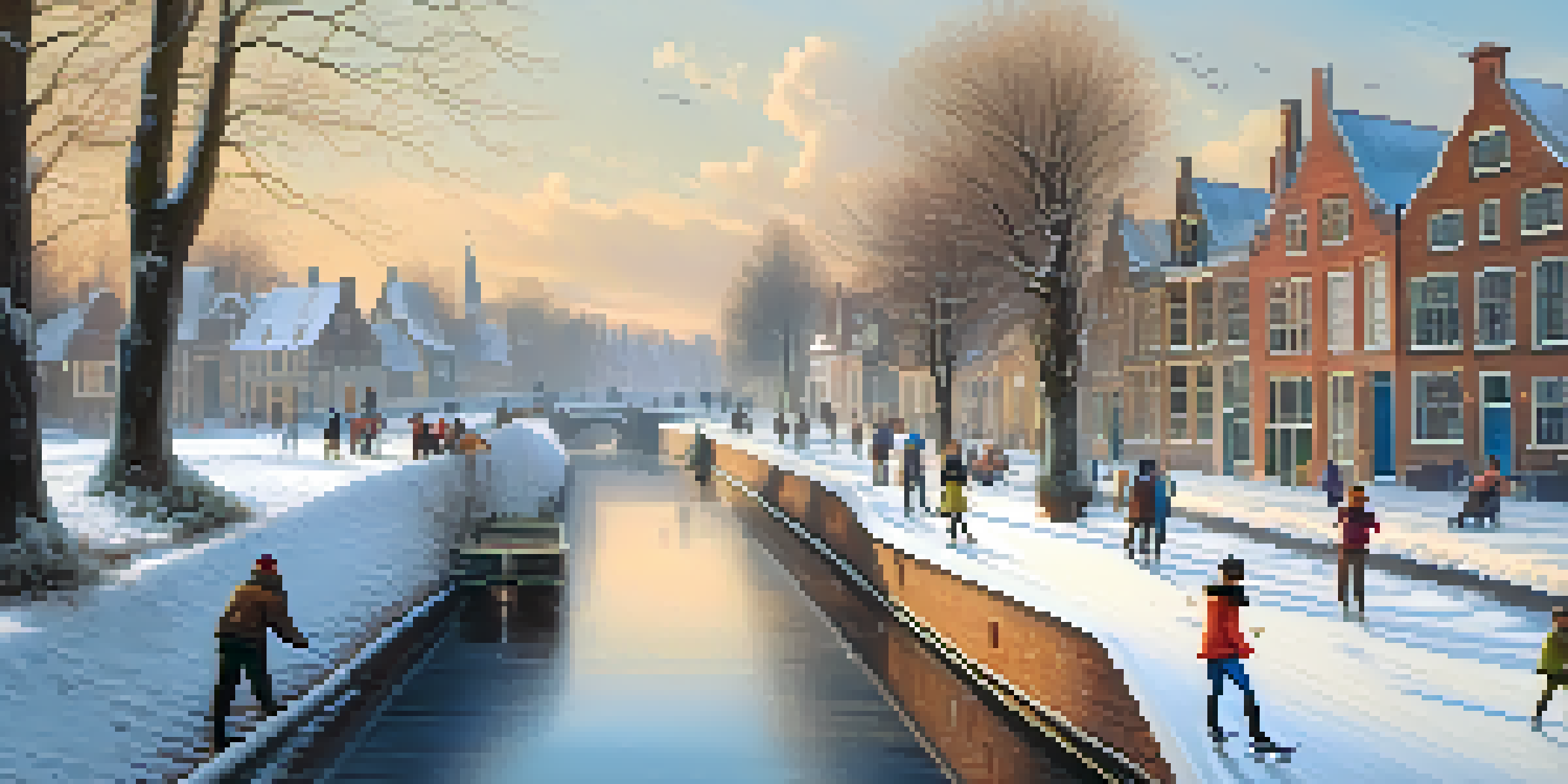Ice Skating in Different Countries: Cultural Variations

The Origins of Ice Skating: A Global Perspective
Ice skating has a rich history that dates back thousands of years, with its origins traced to various cultures around the world. The earliest skates, made from animal bones, were found in Scandinavia, highlighting how ice skating was once a practical means of transportation. Over time, this activity evolved from necessity into a popular recreational sport, with each country adding its own cultural flair.
Ice skating is a dance on ice, and a means to express oneself through sport.
For example, in the Netherlands, ice skating is not just a sport but a national pastime celebrated with the famous Elfstedentocht, a race covering eleven cities. In contrast, countries like Canada and the United States have embraced ice hockey, turning skating into a competitive team sport that captivates millions. These variations showcase how ice skating has adapted to local customs and climates.
Ultimately, the global nature of ice skating reflects a blend of history, culture, and innovation. As we explore different countries, we'll uncover the unique ways they celebrate this winter pastime, revealing not just the sport but the spirit behind it.
Ice Skating in the Netherlands: A National Treasure
In the Netherlands, ice skating is deeply embedded in the culture and is often synonymous with winter itself. The flat landscape and extensive canals provide perfect conditions for outdoor skating, especially during particularly cold winters. Events like the Elfstedentocht are not only sporting competitions but also community celebrations, drawing thousands of spectators and participants alike.

Dutch skaters often embrace the concept of 'schaatsen', which translates to the act of skating but also embodies a way of life during the winter months. The country’s love for the sport is evident from the numerous clubs and rinks that welcome skaters of all ages and skill levels. This passion for skating has also produced world-class athletes who have excelled in speed skating events globally.
Ice Skating's Rich Global History
Ice skating has evolved from a practical means of transportation into a beloved recreational sport, showcasing unique cultural expressions in various countries.
Moreover, the Netherlands has successfully integrated ice skating into its cultural events, such as holiday festivities and markets. As a result, skating becomes a shared experience, fostering social bonds and community spirit, making it a quintessential part of Dutch identity.
Canada: Ice Skating as a Winter Tradition
In Canada, ice skating is more than just a pastime; it's a cherished winter tradition that unites communities. From frozen ponds to outdoor rinks in urban parks, Canadians embrace skating as a way to enjoy the snowy season. The iconic image of families gathering to skate on a lake is a testament to how deeply rooted this activity is in Canadian culture.
The beauty of ice skating lies in its ability to unite people, transcending cultural boundaries.
Ice hockey, a sport that originated in Canada, has played a significant role in shaping the country's skating culture. Young players often start skating as toddlers, learning the basics on backyard rinks before moving on to organized teams. This early introduction fosters a lifelong love for the sport and encourages camaraderie among players and fans alike.
In addition to hockey, figure skating also holds a special place in Canadian hearts, with world-renowned athletes emerging from the country. National competitions and events, like the annual Skate Canada championships, showcase the talent and artistry of Canadian skaters, further solidifying ice skating's status as a vital aspect of Canadian identity.
Japan: Ice Skating with a Unique Twist
In Japan, ice skating offers a blend of traditional and modern elements that reflect the country's unique cultural landscape. Popular winter sports like figure skating and short track speed skating have gained immense popularity, particularly after successful athletes brought home medals from international competitions. This success has sparked a national interest in the sport, inspiring young skaters to pursue their dreams.
Beyond competitive skating, Japan has developed a unique style of recreational ice skating. Rinks often feature beautiful designs and themes, creating a whimsical atmosphere that attracts families and tourists alike. Events like the Ice Show, which combines skating with dance and music, showcase the artistic side of the sport and draw large crowds.
Cultural Significance in Nations
Different countries celebrate ice skating as a vital part of their identity, with events and traditions that foster community and social bonds.
Moreover, traditional Japanese culture influences ice skating in ways that are often unexpected. For instance, the concept of 'wabi-sabi', which appreciates beauty in imperfection, can be seen in the graceful movements of figure skaters. This cultural lens adds depth to Japan's ice skating scene, making it a fascinating blend of sport, artistry, and tradition.
Russia: Ice Skating in a Land of Champions
Russia boasts a rich legacy in ice skating, particularly in figure skating and speed skating. The country has produced numerous Olympic champions and world record-holders, making it a powerhouse in the sport. The rigorous training regimes and dedication to excellence are evident in the performances of Russian skaters, who captivate audiences worldwide.
Ice skating is also a cultural symbol in Russia, often depicted in literature and art. The famous ballet 'Swan Lake' has even inspired ice dancing performances, merging the elegance of ballet with the thrill of skating. This artistic fusion showcases how deeply skating is intertwined with Russian culture and heritage.
In addition to competitive skating, Russians enjoy ice skating in public spaces, especially during the winter months. Outdoor rinks in cities like Moscow become vibrant gathering spots for families and friends, highlighting the communal joy that skating brings to the population. This blend of competition and recreation truly encapsulates the spirit of ice skating in Russia.
Scandinavian Countries: Ice Skating as a Lifestyle
In Scandinavian countries, ice skating is woven into the fabric of daily life during the long winter months. Countries like Sweden, Norway, and Finland have embraced this sport not just as a hobby but as a way to enjoy the stunning winter landscapes. The availability of natural ice on lakes and rivers provides ample opportunity for outdoor skating adventures.
The tradition of 'konka', or 'skating,' in Sweden emphasizes the social aspect of the sport, where friends and families gather to skate together, often ending the day with a warm meal or hot drink. Outdoor skating festivals and competitions are common, drawing participants from all age groups, which fosters a sense of community and shared enjoyment.
Modern Evolution and Inclusivity
As ice skating continues to evolve with new technologies and social influences, it embraces inclusivity and connects diverse communities around the world.
Moreover, the Scandinavian approach to ice skating promotes a healthy lifestyle, encouraging people to stay active during the colder months. The emphasis on enjoying nature while skating reflects a broader cultural appreciation for the outdoors, making it an integral part of life in these countries. Overall, ice skating in Scandinavia exemplifies the harmony between sport and the natural environment.
The Evolution of Ice Skating: From Tradition to Modernity
As ice skating has evolved, it has adapted to modern influences while still honoring its rich traditions. The introduction of new technologies, such as advanced skate designs and training methods, has enhanced the performance of athletes across all disciplines. This blend of tradition and innovation has allowed the sport to grow and reach new audiences worldwide.
Social media has also played a significant role in the evolution of ice skating, with platforms showcasing stunning performances and connecting skaters globally. The visibility of various styles, from artistic to competitive, has encouraged a new generation to take up the sport, expanding its reach beyond traditional boundaries. This democratization of ice skating is refreshing and encourages inclusivity.

Moreover, ice skating has transcended cultural borders, with international competitions fostering a spirit of camaraderie among nations. Events like the Winter Olympics and World Championships celebrate not only athletic prowess but also the shared joy of skating. As it continues to evolve, ice skating remains a symbol of unity and cultural exchange, bridging gaps between diverse communities.
Conclusion: Celebrating the Global Spirit of Ice Skating
Ice skating is a celebration of culture, community, and creativity, with diverse expressions found across the globe. From the frozen canals of the Netherlands to the vibrant outdoor rinks of Canada, each country brings its unique flair to this beloved winter pastime. The stories of athletes, traditions, and communal gatherings highlight the richness of ice skating as a cultural phenomenon.
As we witness the evolution of the sport, it is essential to appreciate the blend of heritage and innovation that keeps ice skating alive and thriving. The accessibility of ice skating encourages participation from all walks of life, fostering connections and shared experiences. This inclusivity is a testament to the sport's enduring appeal and its ability to unite people across borders.
Ultimately, ice skating transcends mere activity; it reflects the spirit of joy and togetherness. As we lace up our skates and glide across the ice, we engage in a timeless tradition that connects us to the past while embracing the future. So whether you're a seasoned skater or a curious newcomer, there's a place for everyone on the ice.